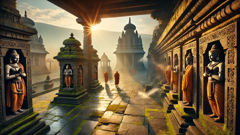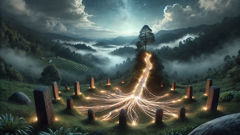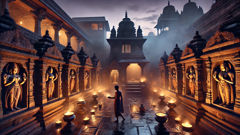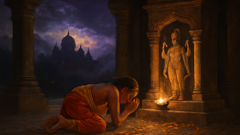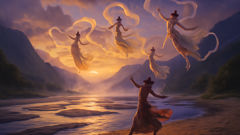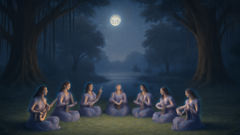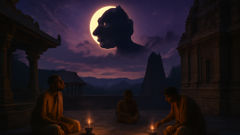Introduction
On the edge of a map drawn with sandalwood ink and memory, the world divides itself into directions as if to measure the reach of gods. East is the first breath; North is patience bound in stone; South holds the heat of endings, West the slow gilding of twilight. In the long-lived imagination of the subcontinent these points of the compass are not mere bearings but persons: the Lokapalas, guardians of the directions who make the invisible geometry of the cosmos into a living, watchful presence. They are not all the same — the Ashtadikpalas in Hindu tradition and the Caturmaharajas in Buddhism differ in number and emphasis — but both families stitch sacred space to human aspiration. Temples are laid out so their thresholds align with a guardian’s vigilance; homes are blessed to incline favorably beneath a deity’s auspice; songs and chants summon names that sculpt the air. Each Lokapala carries a symbol, a temperament, and a story about why boundaries matter. Some carry weapons and thunder, others a noose or money-bag, a spear or a trident; some ride lions, elephants, peacocks, or chariots drawn by wind. Their icons appear on temple plinths, on the lintels above doorways, and in the carved capitals of stone pillars. In the tales that follow, I gather those fragments — oral recollections from temple priests, art historian notes, pilgrims’ murmurs, and a handful of invented episodes intended to make the old logic of direction feel immediate — to present the Lokapalas as both myth and map. Read them not as a dry catalog but as a living compass: each guardian shapes not only space but meaning. The land answers their watch by bending festivals, architecture, and devotion to their design. This is a pilgrimage through cardinal memory, a slow turning of the compass rose that reveals how humans and gods co-author the world.
Origins and Identities: The Ashtadikpalas and Their Symbols
The story of the Lokapalas begins before neat lists: in ritual practice that named and ordered space so households and cities could be lived in without being swallowed by chaos. In the oldest Vedic hymns the world is often described in terms of zones and winds rather than personified guardians. Over centuries, myth and ritual braided, and by the time temple architects and tantric scribes were composing canonical lists, the cardinal directions had found faces. The eight principal guardians — the Ashtadikpalas — form a circle around the sacred center. East, the realm of sunrise and fresh promise, is often entrusted to Indra, the king of gods and lord of thunder. Iconographically he wields a thunderbolt and rides a magnificent elephant; his presence signals rulership and the life-giving rains. Southeast is held by Agni in many traditions, the flame that consumes and transforms, who brings heat and sacrificial energy; he holds a flaming torch or a sacrificial ladle and rides a ram or chariot of smoke. The South, a liminal zone associated with death and rite, is governed in some lists by Yama, the king of the ancestors, who carries a danda (staff) and noose; the South demands moral reckoning and endings as necessary as beginnings. Southwest is sometimes given to Nirrti — a goddess or malevolent aspect associated with decay and misfortune — whose figure cautions communities to respect thresholds where fortune may falter. West responds to Varuna, lord of waters and cosmic law; his net or lasso and the imagery of water anchor him to moral order and hidden depths. Northwest aligns with Vayu, the wind god, ephemeral and restless, whose iconography might show a youthful figure with a banner or a chariot that never touches ground. North belongs to Kubera (also called Vaishravana in Buddhist texts), the treasurer of the world: plump, jeweled, bearing a money-bag or mongoose, he is guardian of riches, abundance, and subterranean storehouses. Northeast — the subtle corner of auspiciousness in Vastu and tantric thought — is overseen by Ishana, an emblematic presence often associated with Shiva or a form of him; Ishana carries a trident and points to transcendence, integrating the cosmic stillness at the intersection of cardinal energies.
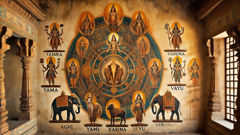
These guardians are distinguishable not only by their symbols but by temperament: Indra's thunder announces public life and ceremony; Agni's flame clarifies oath and ritual; Yama's shadow recalls mortality; Kubera's opulence warns at once of generosity and attachment. Their stories accumulate in local variations. In one village legend an embittered merchant stole Kubera's jewel and found his house visited by drought and misfortune until he returned it. In another, a farmer ignored a devotee's warning to place a small shrine to Agni in the southeast corner of his new home; fuel for the hearth burned without end, and only when the shrine was set did the fires accept their appointed limits. Such anecdotes signal the functional cosmology behind the Lokapalas: they order risk, prosperity, growth, and decline so human life can proceed with sacramental predictability.
Carvers and painters codified these roles with some fluidity. A 9th-century temple facade might depict Indra on the east gate, but local donors could insist on placing Kubera prominently on the north chamber because their lineage traced itself to a treasurer. Art historians sometimes disagree about strict attribution because the gods moved in practice as much as text. The tantric lineage brought a different emphasis: the northeast's Ishana was not only Shiva’s direction but the axis of transcendental practice, where mantras and yantras pointed toward liberation. In palace plans, the king's private shrine aimed to align with Ishana to assert a bond between royal authority and spiritual capital. Meanwhile, Nirrti’s ambiguous presence in the southwest became a litmus test for village ethics: to propitiate that corner was to acknowledge that loss and chaos were domesticed but never removed. The Lokapalas thus create a moral geography where architecture, ritual, and myth keep one another honest.
Beyond Hindu lists, Buddhism offers another map: the Caturmaharajas or Four Heavenly Kings. Their enclosure is simpler — four instead of eight — and they preside over the cardinal points in Buddhist cosmology. Dhritarashtra (east) is a guardian of music and culture, Virudhaka (south) of growth and harvest, Virupaksha (west) watches over vision and seeing, and Vaisravana (north), the same figure often equated with Kubera, watches over wealth and the northern boundary of the dharma. In monasteries, their statues are typically placed at the four corners of temple roofs or central halls to protect the sangha and the teachings. Their image is grimmer and more soldierly than some of the Ashtadikpalas' ritualized benevolence; they are sentinels of doctrine as much as of space. Their origin stories connect to the Buddha’s cosmology of heavenly beings who petitioned the Buddha for teachings and received them, establishing a lineage of protection around the dhamma. Across both traditions, the Lokapalas teach a practical theology: the cosmos is intelligible because someone watches its edges.
Temples elaborate this watchfulness in stone: doorway thresholds often present miniature yakshas or guardian figures embedded in the plinth; the temple's ground plan is a mandala where each corner's deity is invoked with offerings. Vastu Shastra, the classical text of architecture, integrates Lokapala assignments into house plans, market layouts, and even ships. It prescribes which activities flourish in which directions: kitchens in the southeast (Agni), water tanks in the west (Varuna), storerooms in the north (Kubera), and sanctums oriented to the northeast (Ishana). These prescriptions are not mere superstition but pragmatic guidelines that emerged from centuries of observing wind, sun, and soil. Their mythic overlay — the Lokapalas insistently named and ritually propitiated — is what turns pragmatic knowledge into sacred practice. Thus, when a mason aligns the foundation stone with the northeast, the gesture is both technical and devotional: the structure will hold because it honors cosmic law and the guardian who watches that sector.
Oral histories of the Lokapalas live in ritual dances, mural cycles, and festival processions. In some temples, the annual procession moves an image of the local guardian around the precincts so that the deity physically circumscribes its jurisdiction. In other places, merchants walk with Kubera’s image before setting out to trade, whispering small petitions so their cargo will find the right clients. Through these attentive actions, gods remain tethered to human concerns; they become guardians not because they are distant rulers but because they have been obliged, through countless rites, to answer to the edges where human life meets risk and change.
Myths, Rituals, and the Living Compass: Pilgrimage, Temple Lore, and Modern Resonance
If the first section describes the Lokapalas’ names, symbols, and canonical placements, then this section tells how those names became stories people told aloud when dusk came down over courtyards. Temple lore is the place where cosmic theory becomes narrative tool. In one invented but plausible episode, a northern hamlet lost its well to a subterranean collapse. The villagers dug deeper and found a hidden chamber of coin and carved bone — Kubera’s hoard disturbed. For weeks misfortune clung like morning fog. Cattle slipped and refused to breed, marriages faltered, and the well’s water turned shallow and harsh. A wandering brahmacari came with a simple counsel: return what was taken, and build a small shrine to Kubera under the eaves of the north house. They did so, offered a red cloth and a bowl of rice, and the rains resumed their measured generosity. Such narratives codify ethics: theft from the guardian of the north is not merely illegal but sacrilegious. The Lokapalas are thus guarantors of a moral ecology.

Buddhist monasteries developed their own stories: once, a monastery lay on the edge of forest where bandits frequently probed. The monks invoked the Four Heavenly Kings, and overnight the bandits’ path was blocked by dense fog and unseasonal floods. When the robbers returned later, they found their memories confused and their horses skittish; locals said the kings had transformed the terrain itself into an obstacle. Whether or not such miracles occurred materially, they served to create a felt perimeter around sacred institutions. The boundary between the sacred precinct and the outer world must be clear, and the Lokapalas articulate that clarity. In art the Four Heavenly Kings are often carved at the monastery's four corners, their fierce visages aimed outward, making visible the protective barrier.
Ritual practice adapts and renews these stories. Temple consecrations still involve facing and naming the directions. When a new temple is built, the kumbha-abhishekam and the rituals of sthapana include offerings made to the Lokapalas: flowers to the east, incense to the south, food to the north — each corner receives specific petitions. In tantric rituals, the northeast gains prominence: offerings are set so the practitioner can 'enter' Ishana’s stillness, orienting the mind to a vertical axis of spiritual ascent. Folk rituals are more elastic: fishermen pray to Varuna before leaving in the westward tide; shepherds might invoke Vayu in the northwest when winds shape their luck. Vastu consultants remain a living profession whose advice often invokes the Lokapalas directly; their audits translate ancient prescriptions into modern floor plans for apartments and offices. In cities, developers sometimes commission a small north-side shrine to Kubera to gesture toward prosperity, even when pragmatic economic forces are the real drivers.
Beyond ritual, the Lokapalas shape festivals and seasonal cycles. In agricultural communities, processions carry guardian images around fields to protect the land's perimeter before sowing. This is not merely symbolic: a deity’s circuit is a ritualized survey that announces to the world that the field is claimed and tended. Music and dance accompany such circuits; heads of households accompany images of Indra or Agni with drums and lamps, enacting an ancient choreography that reaffirms social order. These processions are living palimpsests where myth and municipal governance overlap: marking property, signaling alliances, and resolving disputes through public recognition. It is how a deity’s watch becomes a civic fact.
Architectural traces are everywhere. In the temple at Bhubaneswar, step-wells in certain localities respond to Varuna’s requisition; in Dravidian south, the axial orientation of raja-gopurams and the placement of dancing halls reflect the guardians’ mapping. In painted murals and stone friezes the Lokapalas appear as sequences of narrative panels — one moment of the image might show Kubera receiving an offering, the next a merchant petitioning him for safe passage. Those panels were not decorative afterthoughts but didactic frames; they taught visitors about the proper stance toward each direction. An infant learning to walk in such a precinct would be enveloped by the same symbols that shaped sacramental acts of kingship and commerce.
Modernity has not erased the Lokapalas; it has made their invocation more flexible. On city balconies, small brass figurines of Kubera sit among potted plants; in apartments, incense to the east is common at dawn; urban temples still paint the four corners with protective mantras. Architects and conservationists rediscover ancient orientation logic not for superstition but for sustainable design: placing windows to the east for morning light, situating kitchens to account for ventilation, respecting solar paths that Vastu knew in a vernacular of observation. Anthropologists note that, even in scientific registries, people often prefer spaces that 'feel' right, and that feeling is frequently described in language that once belonged to the Lokapalas.
To make the guardians more intimate, imagine once more a pilgrim named Meera traveling from a river town to a mountain shrine. She carries a small cloth bundle and a worn brass coin from her mother's purse — a Kubera token that had traveled through three generations. On the path she meets a storm that bends the way, and the western light pools like a mirror in the river. In her dream the river speaks with Varuna's voice: 'Guard the law of water. Speak true when you cross.' Meera wakes, places the coin in the north-side niche of the shrine she finds, and finds herself taken into an older lineage of farmers and priests who have been arranging offerings to the guardians for centuries. The priest tells her of a night when Virupaksha (the western watcher in the Buddhist list) transformed thieves' eyes into water, making them lose their sight of greed. Meera listens, and in returning to her town she becomes, in small ways, a carrier of a local Lokapala story: she will tell her children that the north is where the family tab is kept, where savings are safe because someone watches it. Stories like Meera's are how cosmology becomes a domestic habit.
The Lokapalas also have metaphysical valences. In tantric maps the directions correspond with particular chakras, mantras, and inner practices: aligning one's breath with Vayu, invoking Agni to purify, or turning inward toward Ishana for dissolution of ego. In this frame the directions are not only external coordinates but interior ones: the north of the mind, the east of awakening. Modern spiritual seekers often reinterpret these mappings in therapeutic terms: the South's association with endings corresponds to grief work; the North's treasury symbolizes resources and inner wealth. Therapists and yoga teachers, sometimes unconsciously, fold this vocabulary into practice, offering ancient cartography as a language to describe inner experience.
Finally, the Lokapalas teach an ethic of limits. In a world of boundless desire, guardians remind us that edges are necessary. Gods at the margins are not enemies of expansion; they are calibrators of growth, insisting that a house face the right sun and a commerce heed the right season. Through stone, story, and rite, the Lokapalas keep cosmic life from spinning into formlessness. Their continuing presence across rural fields, urban balconies, murals, and mind maps shows that the human impulse to anchor meaning to direction is as ancient as it is adaptable. The guardians endure because people need a watchful geometry — a compass of care — to live inside the complicated gift of the world.
Conclusion
To speak of the Lokapalas is to speak of how humans make the unseen sensible. These guardians of the directions arrange the world into a net of watchfulness where architecture, ritual, law, and daily habit intersect. They give edges meaning: where a wall begins, a story begins; where a door faces east, a prayer begins with sunrise. Across textual canons and local lore, their names and attributes have shifted, recombined, and traveled between Hindu and Buddhist frames, yet a common logic persists. The Lokapalas are not mere relics of a bygone metaphysics but living interlocutors: they shape how people orient homes, build temples, and narrate misfortune and fortune in ways that remain deeply practical. In contemporary cities they surface in small brass idols on balconies, in Vastu advice for a new apartment, in mural restorations that rediscover ancient orientations. In the inner world, they provide metaphors for practice, where directions become virtues and corners become thresholds for inner change. Whether one sees them as literal protectors or symbolic companions, the Lokapalas remind us that the human need for a compass is more than navigational — it is ethical, aesthetic, and social. The map they propose is at once an infrastructure and an imagination: it asks us to live with attentiveness toward edges, to honor the rhythm of seasons, and to understand that to be protected is sometimes to be taught how to respect the boundary between belonging and taking. If you walk through any temple precinct in India, watch how the stone faces look outward; you will sense a long conversation between humans and directions, a conversation that has shaped how people tend houses, harvest fields, and cast their prayers into the ordered spaces of the sacred.

